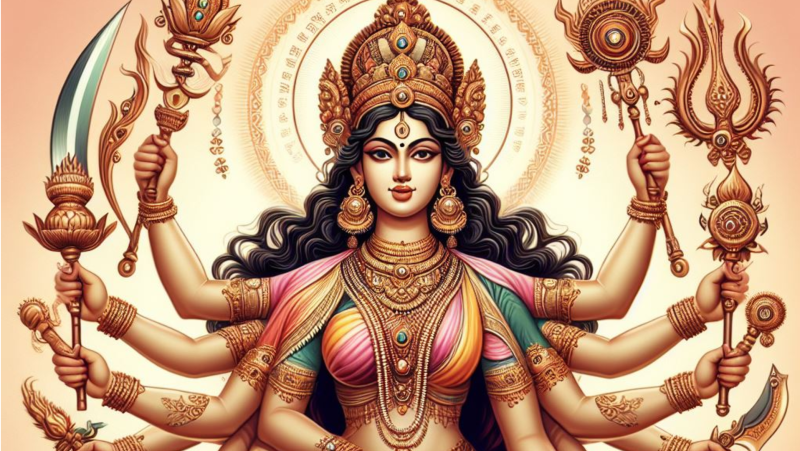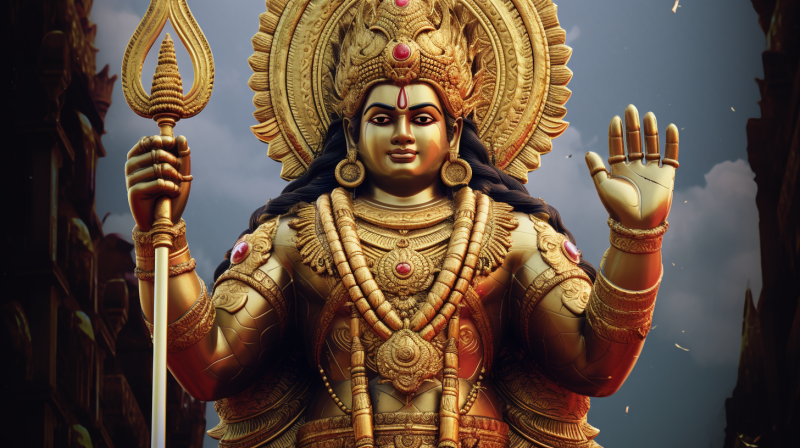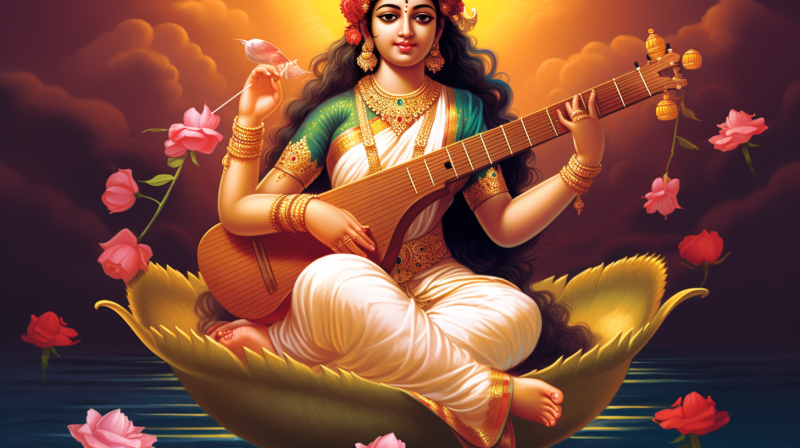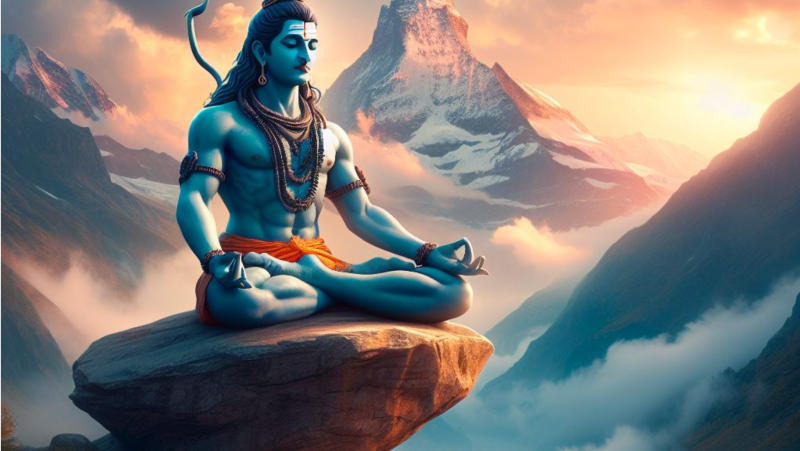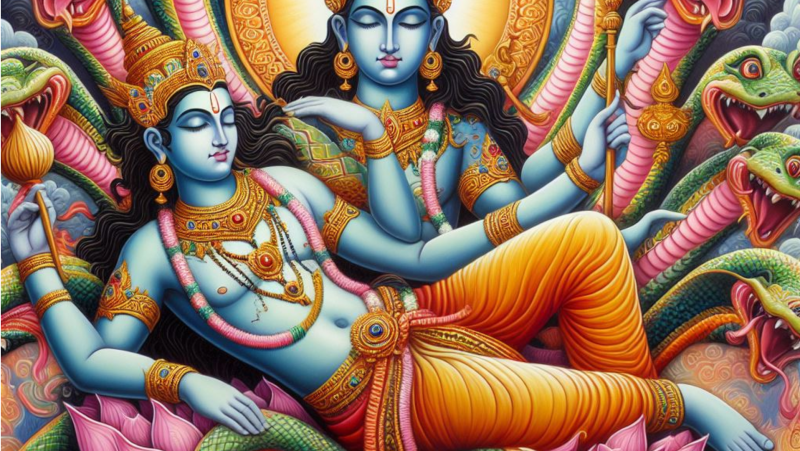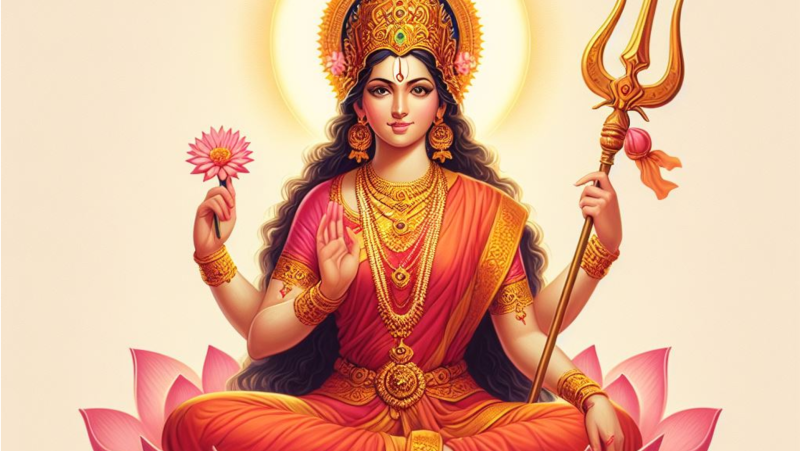
Goddess Parvati, also known as Uma, Gauri, Shakti, Durga, and several other names, is a principal deity in Hinduism. She represents femininity, divine strength, devotion, fertility, and power. Here's a detailed overview of Goddess Parvati:
About Birth And Family Of Goddess Parvati
1. Birth of Parvati:
• Parvati mata is believed to be the reincarnation of Sati, the first wife of Lord Shiva. Sati immolated herself in a sacrificial fire due to her father Daksha's disrespect towards Shiva.
• After Sati's death, she was reborn as Parvati, the daughter of King Himavan (personification of the Himalayas) and Queen Mainavati.
2. Family of Parvati:
• Parents: King Himavan and Queen Mainavati are Parvati's earthly parents. They raised her with love and care in the celestial abode of the Himalayas.
• Sibling: Parvati has a sister named Ganga, the personification of the sacred River Ganges.
• Children: Goddess Parvati has two sons: Ganesha and Kartikeya.
The birth of Parvati mata and her divine family connections are deeply embedded in Hindu mythology, representing the cycle of life, rebirth, and the eternal forces of creation and preservation. Her union with Lord Shiva signifies the harmonious balance between worldly responsibilities and spiritual pursuits.
Parvati's devotion, strength, and role as the divine mother make her an emblem of feminine power and grace in Hinduism.
Characteristics and Depiction of Goddess Parvati
Goddess Parvati, embodies diverse characteristics and is depicted in various forms in Hindu mythology. Here's a detailed overview of the characteristics and depictions of Goddess Parvati:
1. Serenity and Beauty:
• Parvati is often portrayed as a serene, beautiful goddess with a gentle and loving countenance.
• Her physical attributes symbolize grace, elegance, and the epitome of feminine beauty.
2. Attire and Adornments:
• Parvati is depicted wearing traditional attire, usually a red sari or colorful garments symbolizing auspiciousness.
• She adorns herself with exquisite jewelry, including necklaces, earrings, armlets, and anklets, signifying her divine status.
3. Symbolism in Depiction:
• The crescent moon adorns her hair, symbolizing the cyclical nature of time, eternity, and feminine energy.
• Her third eye on the forehead represents higher consciousness, intuition, and divine vision.
4. Maternal Attributes:
• Parvati mata embodies the ideal mother figure, representing nurturing, compassion, and maternal love.
• As a mother, she exudes warmth, protection, and affection towards her children and devotees.
5. Fierce and Protective Forms:
• In her fierce forms such as Durga and Kali, Parvati embodies strength, courage, and the ability to vanquish evil forces.
• As Durga, she rides a lion and holds weapons, portraying her ferocious aspect in battles against demons.
6. Multiple Avatars and Forms:
• Parvati mata assumes various forms and avatars, each representing different aspects of her divine powers and qualities.
• She can manifest as the gentle and compassionate Gauri, the fierce warrior goddess Durga, the nurturing mother Uma, and other forms based on specific attributes.
7. Divine Feminine Energy:
• Devi Parvati represents the divine feminine energy, Shakti, symbolizing strength, creativity, and the primordial cosmic force.
• She exemplifies the balance between feminine tenderness and the power to conquer adversities.
Goddess Parvati's depictions encompass a wide spectrum of qualities, ranging from maternal love, grace, and beauty to fierceness, power, and divine strength. Her various forms and attributes symbolize the multifaceted nature of femininity, serving as an inspiration for devotees seeking empowerment, love, and spiritual elevation.
About Goddess Parvati as Consort of Lord Shiva
Goddess Parvati is revered as the divine consort of Lord Shiva, forming an integral part of Hindu mythology and spirituality. Their union represents the harmonious balance of masculine and feminine energies. Here's detailed information about Devi Parvati as the consort of Lord Shiva:
1. Divine Union:
• Parvati's marriage to Lord Shiva is a central aspect of Hindu mythology, symbolizing the cosmic union of Shiva (the destroyer) and Shakti (the divine feminine energy).
• Their divine union represents the perfect blend of opposites, where Shiva embodies asceticism and detachment, while Parvati represents devotion, love, and domesticity.
2. Legends of Marriage:
• Parvati's intense penance and dedication led her to win Lord Shiva's heart. She undertook severe austerities and sought Shiva as her husband.
• Shiva, initially detached from worldly affairs, was moved by Parvati's unwavering devotion and eventually agreed to marry her.
3. Ideal Marital Relationship:
• The marriage of Devi Parvati and Shiva is considered an ideal and divine marital relationship, where mutual respect, understanding, and complementarity between partners are emphasized.
• Parvati's qualities complement Shiva's ascetic nature, and their union symbolizes the balance between worldly responsibilities and spiritual pursuits.
4. Symbolism of Their Union:
• Their union symbolizes the Ardhanarishvara form, where half of Shiva's body is merged with half of Parvati's, depicting the unity of masculine and feminine energies in the cosmos.
• It signifies the interdependence and inseparability of Purusha (consciousness) and Prakriti (nature).
5. Consort's Roles and Attributes:
• Goddess Parvati is depicted as the caring and nurturing wife, supporting Shiva in his divine duties and assisting him in various cosmic endeavors.
• She exemplifies the ideal consort, demonstrating patience, devotion, and unwavering support for her husband.
6. Consort's Various Forms:
• Goddess Parvati takes various forms based on her attributes and roles, such as Gauri (representing purity and austerity), Uma (depicting light and splendor), and Durga (portraying ferocity and protection).
7. Divine Complementarity:
• Their union exemplifies the concept of Ardhanarishvara, representing the inseparability of masculine and feminine energies, highlighting the need for balance and harmony in life.
Goddess Parvati's role as the divine consort of Lord Shiva symbolizes the essence of a harmonious relationship, where mutual respect, love, and support form the foundation of a spiritually elevated life. Their union represents the unity of cosmic forces and the inseparable bond between the divine masculine and feminine energies in the universe.
About Avatars and Forms of Goddess Parvati
Goddess Parvati, embodies various forms and avatars in Hindu mythology. Each form represents different aspects of her divine powers, attributes, and roles. Here are some of the notable avatars and forms of Goddess Parvati:
1. Gauri: Gauri represents the fair complexion of Devi Parvati. She symbolizes purity, austerity, and marital bliss. Gauri is worshipped as a devoted wife and is venerated for her role as the ideal spouse.
2. Uma: Uma signifies beauty and light. As Uma, Parvati is the daughter of the mountains (Himalayas), and this form emphasizes her radiant and graceful qualities.
3. Durga: Durga is a fierce form of Parvati. She is depicted riding a lion or tiger, wielding weapons in multiple arms, and symbolizes the warrior aspect of the goddess. Durga embodies strength, courage, and the ability to combat evil forces.
4. Kali: Kali is an intense and fearsome form of Parvati. She is depicted with a dark complexion, wearing a garland of skulls, and wielding weapons. Kali represents destruction, time, and the overcoming of ignorance and ego.
5. Kamakshi: Kamakshi represents the goddess as the divine mother. She is depicted as a benevolent and compassionate deity, showering blessings upon her devotees and fulfilling their desires.
6. Annapurna: Annapurna is the goddess of nourishment and food. She symbolizes abundance, nourishment, and the divine provider of sustenance.
7. Mahagauri: Mahagauri is the form that represents serenity and tranquility. She symbolizes purity and inner peace, adorned in white attire.
8. Bhuvaneshwari: Bhuvaneshwari is the goddess who rules the universe. She embodies cosmic power, creation, and the sustenance of the cosmos.
9. Katyayani: Katyayani is worshipped as the warrior form of Parvati. She signifies bravery and valor, arising to fight against evil forces.
10. Shailaputri: Shailaputri represents Parvati as the daughter of the Himalayas. She signifies strength, purity, and devotion to Lord Shiva.
Each form and avatar of Goddess Parvati represents a specific attribute or quality, serving as a source of inspiration, devotion, and guidance for devotees seeking blessings in various aspects of life, including marital harmony, strength, courage, nourishment, and spiritual elevation.
About Roles and Significance of Goddess Parvati
Goddess Parvati, holds multifaceted roles and immense significance in Hindu mythology and spirituality. Here's a detailed overview of the roles and significance of Goddess Parvati:
1. Divine Consort and Ideal Wife:
• Parvati symbolizes the ideal wife, epitomizing love, devotion, and dedication towards her husband, Lord Shiva. Their union represents the perfect marital relationship, balancing worldly responsibilities and spiritual pursuits.
2. Motherly Figure and Nurturer:
• Parvati embodies the nurturing and compassionate motherly figure. As the mother of Lord Ganesha and Lord Kartikeya, she represents maternal love, care, and protection.
3. Goddess of Fertility and Motherhood:
• She is venerated as the goddess of fertility and motherhood, blessing devotees with fertility, marital bliss, and the well-being of children.
4. Symbol of Shakti and Feminine Energy:
• Parvati represents Shakti, the divine feminine energy. She embodies strength, power, and dynamism, exemplifying the balance between gentleness and fierce determination.
5. Warrior Goddess and Protector:
• In forms like Durga and Kali, Parvati assumes fierce aspects, symbolizing the warrior goddess who protects devotees from evil forces and negativity.
6. Source of Wisdom and Knowledge:
• Parvati symbolizes wisdom, intellect, and spiritual knowledge. She guides devotees in their pursuit of wisdom and self-realization.
7. Representation of Harmony and Unity:
• Her union with Shiva symbolizes the harmony between Purusha (consciousness) and Prakriti (nature). This represents the inseparable bond between masculine and feminine energies in the universe.
8. Embodiment of Purity and Devotion:
• Parvati signifies purity, grace, and devotion, inspiring devotees to lead a life based on righteousness, devotion, and dedication to their duties.
9. Role Model for Women:
• Parvati serves as a role model for women, depicting strength, resilience, and the ability to balance various roles in life while maintaining inner strength and spirituality.
10. Cosmic Mother and Universal Force:
• She is revered as the cosmic mother, representing the divine force that nurtures, sustains, and protects all creation.
Goddess Parvati's roles and significance encompass various aspects of life, symbolizing the essence of femininity, strength, love, devotion, and spiritual elevation. Her worship and reverence offer guidance, blessings, and empowerment to devotees seeking fulfillment in both material and spiritual realms.
Abuot Worship and Festivals of Goddess Parvati
Goddess Parvati is revered through various forms of worship, rituals, and festivals across India and other regions where Hinduism is practiced. Here's detailed information about the worship and festivals dedicated to Goddess Parvati:
1. Navratri Festival:
• Navratri, a nine-night festival, is dedicated to the worship of different forms of Goddess Durga, which includes the reverence of Goddess Parvati. The festival signifies the triumph of good over evil.
2. Vasant Panchami:
• Vasant Panchami marks the arrival of spring and is dedicated to Goddess Saraswati, but it's also an occasion to honor Parvati, representing new beginnings, fertility, and wisdom.
3. Gauri Puja:
• Gauri Puja or Gauri Vrat is observed in various parts of India, particularly in Maharashtra, Karnataka, and Gujarat. Married women fast and worship Goddess Gauri (a form of Parvati) for marital bliss and well-being of the family.
4. Hartalika Teej:
• Celebrated primarily in North India, Hartalika Teej is dedicated to Goddess Parvati. Married women observe fasting and perform rituals seeking the long life of their husbands and marital happiness.
5. Gauri Tritiya or Gauri Avahana:
• This festival is celebrated in Karnataka and Maharashtra, where idols of Goddess Gauri (Parvati) are brought into homes and worshiped for prosperity and happiness.
6. Kajari Teej:
• Observed in parts of North India, Kajari Teej is dedicated to Goddess Parvati. Women worship her for the well-being of their children and family.
7. Regional Celebrations:
• Temples dedicated to Devi Parvati, especially those associated with Shakti Peethas, host special celebrations during festivals like Durga Puja, Dussehra, and other local festivities.
• Devotees offer prayers, perform pujas, and conduct rituals dedicated to Parvati during these festivals, seeking her blessings for various aspects of life, especially marital harmony, fertility, and well-being.
8. Personal Worship and Rituals:
• Devotees conduct personal worship at home by chanting prayers, mantras, and performing rituals such as Abhishekam (ritualistic bathing of the deity's idol), offering flowers, incense, and other symbolic items.
Worship of Goddess Parvati during these festivals involves various rituals, prayers, and cultural practices that emphasize devotion, seeking blessings for familial happiness, prosperity, fertility, and spiritual growth. Devotees express their reverence and gratitude towards Parvati through these rituals, seeking her blessings for well-being and fulfillment in life.
Temples dedicated to Goddess Parvati
Goddess Parvati is revered in various temples across India and other regions where Hinduism is practiced. These temples are dedicated to her various forms and aspects. Here's information about some prominent temples dedicated to Goddess Parvati:
1. Kamakhya Temple, Assam:
• Located in Guwahati, Assam, the Kamakhya Temple is one of the Shakti Peethas, and it venerates Goddess Kamakhya, a form of Parvati. It's a significant pilgrimage site where the yoni (female reproductive organ) of Sati is worshipped.
2. Meenakshi Temple, Madurai:
• The Meenakshi Temple in Madurai, Tamil Nadu, is dedicated to Goddess Meenakshi, an avatar of Parvati Mata. The temple complex is renowned for its impressive architecture and cultural significance.
3. Vaishno Devi Temple, Jammu and Kashmir:
• Situated in the Trikuta Mountains in Jammu, Vaishno Devi Temple is a prominent pilgrimage site dedicated to Goddess Vaishno Devi, a manifestation of Parvati. The temple attracts millions of devotees annually.
4. Chamunda Devi Temple, Himachal Pradesh:
• The Chamunda Devi Temple in Kangra, Himachal Pradesh, is dedicated to Chamunda, a fierce form of Parvati. It's a revered shrine and holds cultural importance in the region.
5. Kanchi Kamakshi Temple, Tamil Nadu:
• The Kanchi Kamakshi Temple in Kanchipuram, Tamil Nadu, venerates Goddess Kamakshi, another manifestation of Parvati. It's one of the Shakti Peethas and a significant pilgrimage destination.
6. Sharda Devi Temple, Jammu and Kashmir:
• The Sharda Devi Temple, located in the Neelam Valley of Pakistan-administered Kashmir, is believed to be a revered shrine dedicated to Goddess Sharda, considered a form of Goddess Parvati.
7. Parvati Temple, Pune:
• The Parvati Temple atop Parvati Hill in Pune, Maharashtra, is dedicated to Goddess Parvati. It's a historic temple complex housing temples dedicated to various deities.
8. Shailputri Temple, Jharkhand:
• The Shailputri Temple in Deoghar, Jharkhand, is dedicated to Goddess Shailputri, one of the forms of Parvati, and is revered during the auspicious period of Navratri.
These temples dedicated to Goddess Parvati, in her various forms and manifestations, attract devotees from different regions and hold significant cultural, religious, and spiritual importance in Hinduism. Devotees visit these sacred sites to seek the blessings of Goddess Parvati for various aspects of life, including marital harmony, prosperity, fertility, and spiritual well-being.
You may also like …
Are You The Proud Hindu?
The Trimurti
Create an account to join us and start taking part in conversations.
SIGNIN